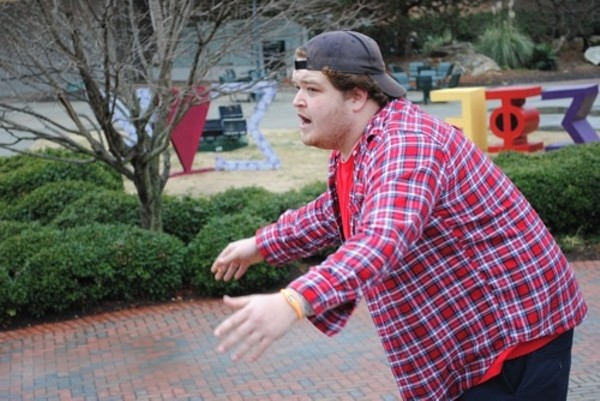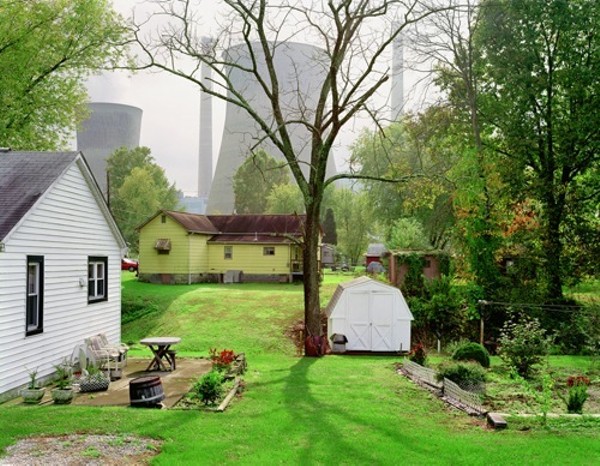Tuesday, February 15, 2011
Performance Art Art + abuse = The People Pleaser?
Posted By Jeff Taylor on Tue, Feb 15, 2011 at 10:48 AM
The importance of civil discourse is driven into our heads from a young age. It’s a cornerstone of polite society. If you don’t have anything nice to say, we’re told, don’t say anything at all. And if you’ve got some built up frustrations, don’t air them in public.
One local artist recently challenged this cultural norm with a performance piece titled The People Pleaser. Joshua “Blue” Haney, a UNCC student and artist openly invited people to yell out their frustrations at him for five minutes while he sat mute and receptive. The idea, Haney said, was “to signify two things, my own feeling of confusion and overload, along with my issue with being a people pleaser.”
Many likely find it quite appealing to vent their frustrations at someone who cannot verbally pass judgment or give them sunny optimistic platitudes in response. In reality, it may turn out to be more difficult than expected. In a way, the performance pressure was placed more solely on the shoulders of the “audience” than on the artist himself. It’s not easy to sit and listen to strangers yell, but neither is it easy to break free of the behavioral patterns you’ve had reinforced for your entire life.
At first, only the artist’s friends and classmates had a go. They yelled at him for smoking. They told him conceptual art was overrated. They said his art project was poorly thought out and doomed to failure because no one cared; only fellow artists were yelling at him and that didn’t really count.
Hainey seemed to be thinking the same thing, as he asked if he could pause, briefly standing up to encourage more participation. “You can’t pause in the middle of an art piece!” Hainey’s professor, Malena Bergmann, admonished. He sat back down and made due with the participants he had, who now seemed even more fired up to tell him what they thought of his art, and his existence in general. Eventually, this loosened a few of the two dozen or so in attendance. One woman walked up and vented about the college’s parking situation. A young man followed, asking, “Why does Walmart suck to work for?”
Hainey remained silent, taking drags off his cigarette and occasionally checking his watch, as things began drifting into the absurd. “You peed on the floor again!” shouted one man, as if Hainey were a misbehaving dog. Another, who after the performance was revealed to me to be Hainey’s best friend, pushed him flat on the ground before taking his shoes and chucking them across the plaza.
When the five minutes were up it was Hainey’s turn to dish it out. He took the nonparticipants to task for being passive, for not caring about art, and for failing to try something new even though that’s what college is supposed to be all about. He finished strong: “Do something! You’re here, make a movement. Do it! It’s now. We live one time, one time only.”
Finally all those quiet onlookers let out one big, group scream. “Thank you!” said a visibly relieved Hainey.
So was the piece a success?
“I think it went okay,” Hainey said. “It could have been a lot better if more people had shown up and gotten caught up in the moment and participated. However, as far as the simple communication of my concept, I’d say it was successful.”
“It was an extremely cathartic experience,” he said of getting to yell back at the crowd (which, it turns out, was planned and signified his breaking away from being a chronic people pleaser). “I shook for about 30 minutes after. It was so cleansing to scream my frustrations out at the world.”
One can’t help but wonder if the experience was more fulfilling for the artist than the audience, but considering the performance’s concept, that seems a fitting outcome.
A video of the event follows. (Please be forewarned that there is strong language used throughout.)
Tuesday, February 8, 2011
Visual Art / Events Art Review: PEOPLE PLACES POWER
Posted By Barbara Schreiber on Tue, Feb 8, 2011 at 10:48 AM
Industry and government have long altered the landscape as if they were producing land art’s evil twin, creating exquisite scars that are the visual evidence of our need for power. Some of the most compelling photographs in PEOPLE PLACES POWER: Reframing the American Landscape, on view at the Davidson College Art Galleries through February 25, document this phenomenon.
The subject matter of these photographs gives them their moral authority. But it is the cruel, unearned beauty of the forms depicted — a gash of city light in the desert night, the elegant curve of a cooling tower, a single fence at the border — that draws us in, enmeshing us in a queasy, guilt-ridden relationship.
The exhibition’s dominant image — it’s not only the centerpiece of the publicity, but it quietly assaults you as you first enter the galleries — is Mitch Epstein’s "Amos Coal Power Plant, Raymond, West Virginia." In this subdued display of twisted normalcy, cooling towers loom behind a modest, pleasant neighborhood with a mix of paternalism and threat. The gray towers almost blend in with the sky, giving the whole image a weird sense of intimacy and rightness.
Some images seem to depict a struggle in which nature is victorious. Andrew Moore’s "Model T HQ, Detroit" shows a ruined interior with what at first glance appears to be the remains of a filthy green carpet — but is in reality a moss-covered floor. Victoria Sambunaris’ "Wendover, Utah" portrays a dreary, isolated development that stands in sad contrast to the pristine mountains in the distance.
I’m a total sucker for images of the majestic, exploited landscape, so it's probably due to personal taste that my energy started to flag in the final gallery, with its emphasis on people and personal drama. This is not to disparage the many noteworthy photographs in this space, among them David Hilliard’s poignant "Dad," a pensive, perhaps defeated figure viewed through the window of his house, as well as "Tracy (Cherry Drizzle)" by art star Ryan McGinley. There is simply an abundance of work in this exhibition that demands serious consideration, and even with a spare installation that allows each piece to speak for itself, there is almost too much to view. This show is a must-see; just make sure you allot plenty of time.
While doing the preliminary research for PEOPLE PLACES POWER, gallery director Brad Thomas (who gets high marks for the restrained, intelligent curating of this exhibition and pretty much anything else that crosses his path) learned that Mitch Epstein and author Susan Bell were collaborating on WHATISAMERICANPOWER.COM, a public art project involving a website and billboards in Cincinnati and Columbus, Ohio. Epstein and Bell agreed to extend the project to include a poster campaign in Davidson and the Charlotte area. To participate in Poster – Picture – Post: A Community Collaboration, pick up a free poster at the gallery before February 25, mount it (with permission) in a public space, then document it and post your image on the gallery’s Facebook page.
— Barbara Schreiber






